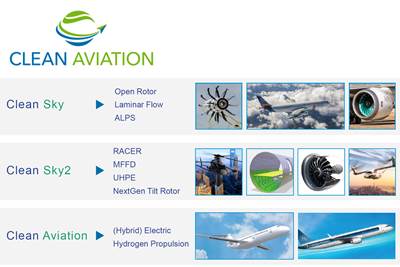Aerospace Technology Institute unveils concept for liquid hydrogen-powered aircraft
FlyZero project posits 279-pax midsize jetliner; will publish technology roadmaps for wings, H2 tanks and cryo fuel systems in early 2022.

FlyZero project long-range aircraft concept. Photo Credit: ATI
Developed by a team of U.K. aerospace and aviation experts under the government-backed FlyZero project, a midsize, long-range aircraft concept revealed by the Aerospace Technology Institute (ATI, Cranfield, U.K.) demonstrates the potential of green liquid hydrogen for air travel not just regionally or in short-haul flight, but for global connectivity. More importantly, the midsize concept will meet the demands of a sector of the market between single-aisle and widebody aircraft operations, which together account for 93% of aviation’s carbon emissions.
ATI FlyZero’s midsize aircraft concept demonstrates a zero-carbon emission aircraft capable of carrying up to 279 passengers globally with only one stop, and at the same speed as today’s aircraft. With a range of 5,250 nautical miles (NM) destinations including San Francisco (4,664 NM), Delhi (3,642 NM), Beijing (4,414 NM), Vancouver (4,105 NM), Mexico City (4,815 NM) and Rio De Janeiro (4,983 NM) are within reach from London. Destinations including Auckland (9,911 NM), Sydney (9,188 NM) and Honolulu (6,289 NM) are in reach with just one stop.
Powered by liquid hydrogen, the fuel is stored in cryogenic fuel tanks at around -250ºC in the aft fuselage and two smaller “cheek” tanks along the forward fuselage. These cheek tanks also serve to keep the aircraft balanced as the fuel burns off and eliminate the need for any additional aerodynamic structures. The aircraft’s 54-meter wingspan carries two turbofan engines powered by hydrogen combustion.
“At a time of global focus on tackling climate change, our midsize concept sets out a truly revolutionary vision for the future of global air travel keeping families, businesses and nations connected without the carbon footprint,” says FlyZero project director Chris Gear. “This new dawn for aviation brings with it real opportunities for the U.K. aerospace sector to secure market share, highly skilled jobs and inward investment while helping to meet the U.K.’s commitments to fight climate change.”
Liquid hydrogen is a lightweight fuel, which has three times the energy of kerosene and sixty times the energy of batteries per kilogram and emits no CO2 when burned. While there are still technological challenges that exist for liquid hydrogen-powered flight, the shift toward hydrogen energy continues to develop an incentive toward its realization. According to ATI, a new generation of highly efficient hydrogen-powered aircraft with low fuel costs is forecast to have superior operating economics than conventional aircraft from the mid-2030s onwards.
Through the development of concept aircraft, FlyZero has identified onboard technologies which, together with the infrastructure and ground equipment for refueling, require rapid development to deliver zero-carbon emission flight. These advanced technologies include wings without fuel tanks (dry wings), hydrogen tanks, cryogenic fuel systems, fuel cells and electrical power systems and hydrogen gas turbines.
Projects already funded by ATI and exploring composites as potential solutions include:
- Airbus (Toulouse, France) projects: Wing of Tomorrow (most recent developments, “Out-of-autoclave VBO rear spar, thermoplastic ribs target Wing of Tomorrow,” and “FACC successfully develops novel composite flap system for Wing of Tomorrow”) will develop new technologies and manufacturing processes to produce next-generation composite wings and help Airbus’ leading position in the single-aisle market. A critical part of the program is to develop capability to manufacture more efficient, lightweight carbon fiber wings at a rate much higher than previously possible.
- Rolls-Royce (London, U.K.) projects: UltraFan will be the most efficient engine produced by Rolls-Royce and will use less fuel and produce lower CO2 emissions (see “Rolls-Royce begins building UltraFan aeroengine prototype”). Projects funded as part of the £200 million will drive efficiency and contribute towards shared government and industry ambitions on decarbonization.
- Williams Advanced Engineering (Wantage, U.K.): The AIRTEK project is focused on developing lightweight seat structures for the civilian aerospace sector. Williams Advanced Engineering, in a collaboration with JPA Design (London) and SWS Certification (Wales), is developing new lightweight aircraft seats in order to reduce the weight of aircraft, which in turn will lead to airlines saving fuel and CO2.
- Safran Electrical & Power UK (Pitstone): The Aerospace Electric Propulsion Equipment, Controls & Machines (AEPEC) project involves lead partner Safran Electrical & Power UK and its supply chain partners. They will develop electrical power systems to improve energy use on future aircraft, covering power generation, control systems and other functions on electric aircraft.
In early 2022, detailed findings from the FlyZero project will be published including three final aircraft concepts (regional, narrowbody and midsize), technology roadmaps, market and economic reports and a sustainability assessment. These outputs will help shape the future of global aviation with the intention of gearing up the U.K. to stand at the forefront of sustainable flight in design, manufacture, technology and skills for years to come.
“The Aerospace Technology Institute’s pioneering research highlights the potential for hydrogen in realizing zero-carbon global connectivity. This ground-breaking green technology looks set to play a critical role in decarbonizing flight and through the work of the Jet Zero Council, the U.K. aviation sector is exploring all avenues to ensure we protect the benefits of flying for future generations, while cutting the carbon cost,” concludes Jet Zero Council CEO Emma Gilthorpe.
Related Content
Plant tour: Joby Aviation, Marina, Calif., U.S.
As the advanced air mobility market begins to take shape, market leader Joby Aviation works to industrialize composites manufacturing for its first-generation, composites-intensive, all-electric air taxi.
Read MoreInfinite Composites: Type V tanks for space, hydrogen, automotive and more
After a decade of proving its linerless, weight-saving composite tanks with NASA and more than 30 aerospace companies, this CryoSphere pioneer is scaling for growth in commercial space and sustainable transportation on Earth.
Read MoreWelding is not bonding
Discussion of the issues in our understanding of thermoplastic composite welded structures and certification of the latest materials and welding technologies for future airframes.
Read MoreComposites manufacturing for general aviation aircraft
General aviation, certified and experimental, has increasingly embraced composites over the decades, a path further driven by leveraged innovation in materials and processes and the evolving AAM market.
Read MoreRead Next
EU launches Clean Aviation partnership, targeting 75% of civil fleet replaced for zero emissions by 2050
Clean Aviation carries forward from Clean Sky to develop disruptive new technologies, flight demonstrated by 2029 for aircraft into service by 2035 and aviation climate neutrality by 2050.
Read MoreVIDEO: High-volume processing for fiberglass components
Cannon Ergos, a company specializing in high-ton presses and equipment for composites fabrication and plastics processing, displayed automotive and industrial components at CAMX 2024.
Read MoreDeveloping bonded composite repair for ships, offshore units
Bureau Veritas and industry partners issue guidelines and pave the way for certification via StrengthBond Offshore project.
Read More


























